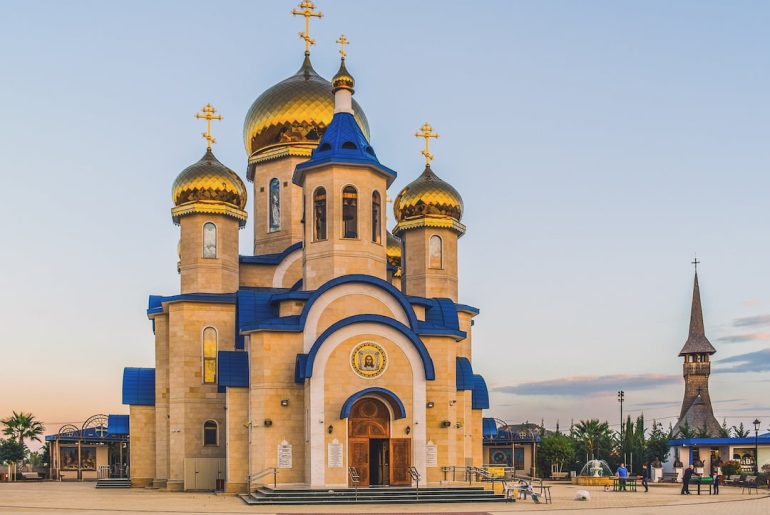Russian architecture is a rich and diverse discipline encompassing centuries of history, cultural influences, and artistic expressions. From the medieval churches of Novgorod and Vladimir to the grand palaces of St. Petersburg and Moscow, Russian architecture reflects the country’s complex blend of Byzantine, Gothic, Renaissance, baroque, neoclassical, and modernist styles.

The iconic onion domes of Orthodox churches stand as a testament to their distinctive religious identity, while the imposing facades of tsarist buildings exude power and luxury. Furthermore, Russian architecture has been shaped by sociopolitical changes throughout history- from Peter the Great’s Westernization efforts to Soviet-era constructivist experiments. By studying Russian architecture in-depth, professionals gain insights into how architectural innovations have been influenced by broader historical contexts while appreciating creative approaches contributing to Russia’s unique architectural heritage.
Who are some famous Russian Architects?
Russia has a rich architectural history with notable architects who have left their mark on the country’s landscape. One of the most renowned figures is Ivan Zholtovsky, known for his neoclassical and art deco designs. He crafted several iconic buildings in Moscow, including the House on Embankment and the State Lenin Library. Another prominent name is Fyodor Schechtel, regarded as a pioneer of Russian Art Nouveau. His masterpiece, the Yelagin Palace in St. Petersburg, showcases his distinctive style, blending various architectural influences.

A contemporary architect making waves internationally is Zaha Hadid, born in present-day Russia during Soviet times but later immigrated to Britain. Specializing in avant-garde designs characterized by fluid lines and daring concepts, she has revolutionized modern architecture and was the first woman to receive the prestigious Pritzker Architecture Prize. These architects have contributed significantly to shaping Russia’s architectural identity and left an indelible legacy on both domestic and global scales through their innovative creations.
What are the iconic landmarks of Russian Architecture?
Russian architecture is renowned for its iconic landmarks that showcase the country’s rich cultural and historical heritage. The Kremlin, located in Moscow, is one of Russia’s most recognizable symbols. This fortified complex boasts a stunning ensemble of architectural wonders, including the Assumption Cathedral with its golden domes, the Grand Kremlin Palace with its ornate facade, and the Tsar Bell and Tsar Cannon. Another must-see landmark is St. Basil’s Cathedral, with colorful onion-shaped domes on Red Square.
This masterpiece reflects the unique and flamboyant style prevalent during the reign of Ivan IV. In addition to these prominent sites in Moscow, Saint Petersburg is home to numerous architectural marvels like the Winter Palace—an extraordinary example of Baroque design—alongside magnificent cathedrals such as St. Isaac’s Cathedral and Kazan Cathedral. These iconic landmarks contribute to the grandeur and allure of Russian architecture, leaving visitors awe-inspired by their beauty and historical significance.
What is the history of Russian Architectural styles?
The history of Russian architectural styles is rich and diverse, influenced by various cultural and historical factors. In ancient Rus, the roots can be traced back to, greatly influenced by Byzantine architecture. One of the most significant contributions to Russian architecture was made by Ivan III in the 15th century when he established the Moscow Kremlin as the political and religious center of the country, resulting in the emergence of a unique style known as the Muscovite Baroque. However, under Peter the Great’s rule, Russian architecture experienced a transformation with an infusion of European styles, including Neoclassical and Rococo.
It continued during Catherine the Great’s reign when architectural elements from different cultures, such as Greek, Italian, and French, were incorporated into buildings. In the 19th century, Romanticism and Eclecticism became dominant styles, followed by Art Nouveau at the turn of the 20th century. The Soviet era introduced Constructivist designs characterized by functionalism and simplicity. Today, contemporary architecture is a blend of modernist influences and an emphasis on preserving historic landmarks while incorporating innovative urban planning and design concepts.
How did the Soviet era influence Russian Architecture?

The Soviet era had a profound and lasting influence on Russian architecture, reshaping the entire landscape of the country. From 1917 to 1991, it introduced new ideologies and principles that influenced architectural design in Russia and throughout the wider Soviet Union. Under Soviet rule, architecture became a tool for promoting the ideals of Communism and state power, creating monumental structures such as government buildings, administrative centers, and grand public spaces.
The regime favored utilitarian designs prioritizing functionality over aesthetics, resulting in standardized, mass-produced housing blocks known as “khrushchyovkas.” Additionally, a shift towards industrialization led to experimentation with new construction materials and techniques. However, despite its emphasis on uniformity and utility, the Soviet era also brought about innovative advancements in constructivism and modernist architecture through pioneers like Vladimir Tatlin and Konstantin Melnikov. Ultimately, the influence of the Soviet era can still be seen today in the architectural fabric of Russian cities as a reminder of an influential period in history.
How does traditional Russian Architecture differ from Contemporary Designs?

Traditional Russian architecture and contemporary designs showcase stark differences in style, materials, and functionality. Ornate decorations, vibrant colors, and unique domed structures characterize conventional Russian architecture. The most iconic example of this style is the onion-shaped domes on buildings such as St. Basil’s Cathedral in Moscow. In contrast, contemporary designs favor clean lines, minimalist aesthetics, and modern materials such as glass and steel.
These designs prioritize simplicity and functionality over intricate details. Additionally, tradition often incorporates religious symbolism due to the strong influence of Orthodox Christianity, whereas contemporary designs tend to focus more on sustainability and energy efficiency. While traditional architecture showcases a rich cultural heritage, contemporary designs reflect a more progressive approach that aligns with current architectural trends.
What role does the Russian Orthodox Church play in Russian Architectural Style?
The Russian Orthodox Church is indispensable in shaping Russian architecture’s distinct and iconic style. Drawing inspiration from Byzantine and Eastern Orthodox traditions, it showcases a rich fusion of ornate decorative elements, towering domes, and intricate facades. The influence of the Russian Orthodox Church is evident in numerous renowned structures throughout Russia, such as the famous St. Basil’s Cathedral in Moscow, either Moscow or the Cathedral of Christ the Savior.
These architectural masterpieces testify to the church’s long-standing influence on Russian aesthetics and culture. Religious importance is also reflected through architectural concepts like onion-shaped domes and intricate frescoes inside churches, which vividly depict biblical scenes. Thus, by blending sacred symbolism with unique architectural forms, the Russian Orthodox Church has played a pivotal role in defining and preserving Russia’s diverse architectural heritage while creating spaces that inspire devotion and awe among its followers.
What are some notable examples of the Imperial Architecture of Russia in St. Petersburg?
St. Petersburg, the imperial capital of Russia, boasts a magnificent array of architectural masterpieces that reflect the grandeur and luxury of the country’s imperial past. Among the most notable examples of Imperial Russian architecture in St. Petersburg are the Winter Palace and the Peterhof Palace. The Winter Palace, designed by renowned Italian architect Bartolomeo Rastrelli, is an awe-inspiring example of Baroque architecture with elaborate facades decorated with white and turquoise ornaments.

Another remarkable example is the Peterhof Palace, often called the “Russian Versailles.” This enchanting complex was commissioned by Peter the Great and later expanded by his daughter Elizabeth, featuring stunning gardens adorned with fountains, sculptures, and cascades held together by charming neoclassical buildings. These iconic structures encapsulate finesse and grandiosity, showcasing Russia’s imperial heritage through sheer extravagance while leaving a lasting impression on visitors worldwide.
How has Russian avant-garde influenced the Modern Architecture of Russia?
The Russian avant-garde movement, which emerged in the early 20th century, has profoundly influenced the modern Architecture of Russia. This movement brought together artists such as Vladimir Tatlin, El Lissitzky, and Kazimir Malevich, who sought to break away from traditional artistic forms and embrace new design and construction principles. The avant-garde movement emphasized geometric shapes, clean lines, and the use of industrial materials such as glass and steel. These ideas directly impacted modern Russian architecture by promoting functionalism, efficiency, and simplicity in design.
Renowned constructivist architects like Moisei Ginzburg and Ivan Leonidov incorporated these principles into their plans for residential buildings, government structures, and public spaces across Russia. Today, this legacy can be observed in the contemporary Architecture of Russia through its distinct emphasis on dynamic forms, geometric facades, and minimalistic interiors that reflect the avant-garde philosophy that continues to shape the industry. Ultimately, the influence of the Russian avant-garde movement on modern Russian architecture cannot be understated, as it fundamentally reshaped design principles and paved the way for innovative architectural solutions still seen today.
Conclusion
Russian architecture is a diverse and rich field that reflects the country’s turbulent history. It showcases a unique blend of styles from medieval Orthodox churches to Soviet-era buildings. Grandeur, intricate details, and a sense of monumentality characterize the architecture of Russia. Famous structures like St. Basil’s Cathedral and the Hermitage Museum exemplify this style. Furthermore, it demonstrates an understanding of its natural surroundings, with features designed to withstand varying climates. It represents cultural identity and showcases its builders’ craftsmanship, innovation, and resilience.






